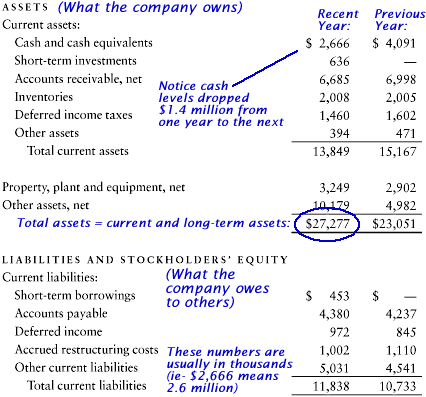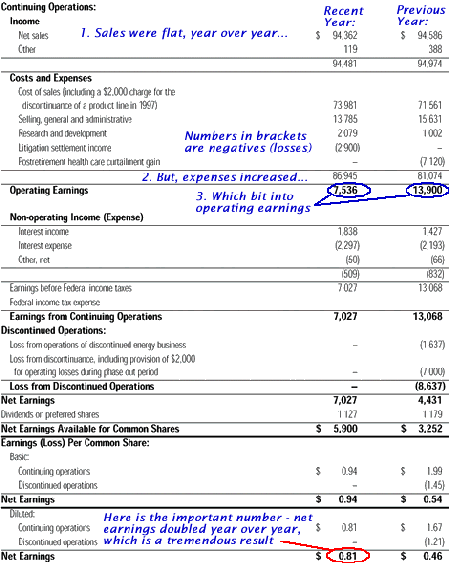


Get Instant Penny Stock Picks from the Authority!Visit www.PeterLeeds.com Right Now!
Financial statements are a useful tool for judging the health of a penny stock company, and for comparing it to its competitors.
They show what the company owes and owns, the profits or losses it has made over a given period, and how their position has changed since their last statement.
Generally if you can tell which direction penny stocks are heading, you can also forecast future stock prices with some accuracy.
Gaining a basic knowledge of financial statements, and applying this knowledge when choosing or assessing investments can help you pick tomorrow's winning penny stocks, while avoiding tomorrow's losers.
Of course, financial statement analysis will not forecast future events and unexpected situations which may influence the share prices of the penny stocks, but it provides a starting point from which to gauge the present value of shares.
Although the topic can get much deeper and more complex, this section is designed to give you the ability to understand the numbers and implications of the statements. This knowledge should assist you to make better decisions when doing your due diligence.
The balance sheet shows a penny stock's financial position at a specific date.
One part of the balance sheet shows what the company owns and has owing to it, called assets.
The other part represents liabilities, which are what the company owes. The liabilities also includes shareholders' equity, which represents the excess of the company's assets over its liabilities. Shareholder's equity is often referred to as book value. Many penny stocks have negative (or nil) book values.

Total assets are equal to the sum of the penny stocks liabilities plus the shareholders' equity. In other words, take away liabilities from assets and the remainder is what value is owned by the shareholders.
The Balance Sheet can be used to uncover the value of the penny stock company, the debt load, and cash position.
Also called the Income Statement or Profit and Loss Statement, it shows how much revenue a company received during the year from the sale of its products and services, and the expenses the company incurred due to wages, taxes, operating costs, etc...
The difference between revenues and costs is the company's profit or loss for the year. Many penny stocks are operating at a loss.

Net earnings reveal how much money the company ‘really' made over the course of the year. Some penny stocks can have low earnings if they used much of their money for research and development, to acquire other companies, fuel aggressive growth, move into new markets, etc...
Some penny stock companies have low or negative earnings because they didn't generate enough revenues to cover their expenses, or their costs were too high, etc... Be careful of these type of penny stocks.
This shows how the penny stock company's financial position changed from one year to the next. Also called the cash flow statement, this details how the company generated and spent its cash during the year.
This statement can be used in evaluating the liquidity and solvency of a company, and to assess the ability of that company to generate cash internally, to repay debts, to reinvest in itself, etc... Keep a close eye on this aspect of the financials when dealing with penny stocks.
Certainly you can get financials from the companies themselves. Most will gladly fax them to you, or mail you their latest quarterly and annual reports.
However, a faster way to access the information can be by the Internet.
For example, go to Yahoo.com and choose stock quotes. Enter the ticker symbol for the company you are interested in, and Yahoo will provide its most recent press releases, which will include past quarterly and annual reports with the financial statements.
You can also check the previous reports to compare which direction the penny stocks' operations are moving in, and look for trends (i.e. increasing debt load, unpredictable earnings, decreasing revenues, erratic spending, etc...).
There are also many other Internet resources which provide similar information, which we detail earlier in All About Penny Stocks.
To familiarize yourself with some of the numbers, try looking up the financials of three penny stocks you own or are interested in.
Financial statements can provide investors with a partial fundamental snapshot of a company. They only represent one piece of the puzzle. Remember that, while financial statements can help investors compare several penny stocks, that comparison is limited only to the numbers provided.
In other words, you can see that one company made money while the other lost money, but you don't know which has the better technical outlook (based on analysis of the trading chart), which is a potential takeover target, which will have the best future earnings, etc...
As well, the impact of financial statements tends to be long-term as it relates to share prices. Four quarterly reports showing increasing earnings may push the penny stock into an upward trend as the market begins to recognize the improvements of the underlying company, but one single quarter of increasing earnings may or may not have a significant impact on shares.
Therefore, most investors use financial statements as part of a greater overall decision making process in penny stocks. Certainly, an understanding of the data can benefit any investor who takes the time to make educated trading decisions.
Many growth companies don't need nor are expected to have positive earnings. Instead, they generally accumulate debt as they focus on research and development of new technologies, aggressively move into new markets, fight for market share with competitors, etc...
Other penny stocks with minimal growth prospects should have more importance placed on actual earnings, lowering operational costs, etc...
Be sure to understand what numbers are important and unimportant to a specific type of penny stock based on their situation and the sector they are in. This can be done easily by doing an industry comparison on the company in question. Do penny stocks in the same industry or sector seem to have positive earnings, or is the focus on growth, research, etc... Are they a larger or smaller company than the industry average, and are they growing faster than the others?
Read the fine print to make sure the numbers you are reading have been audited, rather than being just company estimates, or unverified results. This generally is not something you need to worry about with most exchange-listed companies, but it is important practice.
Many annual statements will begin with positive news about sales or revenue increases, or other positive comments, but further reading reveals that the company actually lost money, increased debt, or had a poor quarter or year. For most companies their financial statements are part of their promotional material and they need to make the information sound as impressive and positive as possible, even if the overall results were disappointing.
Be wary of one-time earnings or losses. For example, a company may win a huge lawsuit settlement and the influx of money gives them positive earnings for the quarter. However, how would they have done when the one-time extraordinary gain is ignored?